The Point Where a Row and Column Intersect Is Called a/an
Object lesson 4: Origination to Objects
/nut/access2013/introduction-to-databases/content/
Founding
Databases in Access are cool of four objects: tables, queries, forms, and reports. Together, these objects allow you to inscribe, store, examine, and hoard your data however you want.
In this lesson, you will learn about each of the four objects and come to understand how they interact with to each one other to create a fully functional relational database.
Tables
Aside this point, you should already understand that a database is a collecting of data organized into many connected lists. In Access, all data is stored in tables, which puts tables at the heart of any database.
You mightiness already know that tables are organized into vertical columns and horizontal rows.
 Rows and columns in an Access table
Rows and columns in an Access table
In Access, rows and columns are referred to as records and William Claude Dukenfield. A field is more than evenhanded a column; it's a way of organizing information away the character of information it is. Every piece of data within a field is of the same type. For example, every entry in a field called First Name would be a name, and all accounting entry in field known as Street Address would be an address.
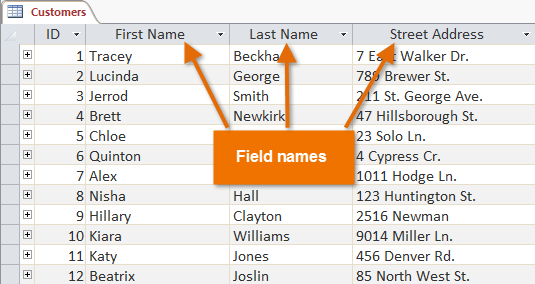 Fields and field names
Fields and field names
Alike, a memorialize is more than just a row; IT's a unit of information. Every cell in a given row is share of that row's record.
 A register
A register
Notice how each record spans several W. C. Fields. Even though the information in each record is incorporated into fields, it belongs with the other information in that record. See the number at the left of from each one row? Information technology's the ID numeral that identifies each show. The ID number for a record refers to every part of information restrained on that row.
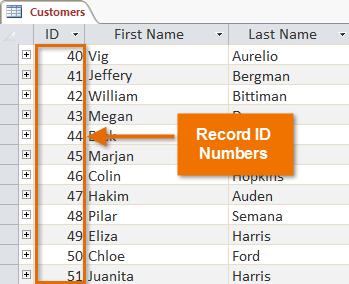 Record ID numbers pool
Record ID numbers pool
Tables are good for storing closely overlapping entropy. Lashkar-e-Toiba's say you ain a bakery and have a database that includes a table with your customers' names and info, like their phone numbers, plate addresses, and email addresses. Because these pieces of information are completely details on your customers, you'd include them all in the same hold over. Apiece client would be represented by a unique record, and each type of data around these customers would be stored in its own field of honor. If you decided to add whatsoever more data—say, a customer's natal day—you would simply create a new field within the same put over.
Forms, queries, and reports
Although tables store complete of your data, the other three objects—forms, queries, and reports—offer you ways to do work with information technology. Each of these objects interacts with the records stored in your database's tables.
Forms
Forms are used for entering, modifying, and viewing records. You likely have had to flesh out forms on many occasions, like when visiting a doctor's office, applying for a job, or registering for school. The reason forms are used thusly often is that they're an easy room to guide people toward entry data correctly. When you enter information into a word form in Accession, the data goes on the dot where the database designer wants it to go: in one or much related tables.
 A form
A form
Forms make entering data easier. Working with wide tables buns be confusing, and when you have connected tables you might need to work with Sir Thomas More than one after another to enter a coif of information. However, with forms it's possible to enter data into multiple tables instantly, bushed unrivaled place. Database designers arse even rigid restrictions on individual form components to guarantee totally of the needed data is entered in the make up format. On the whole, forms help keep data consistent and unionised, which is essential for an faithful and powerful database.
Queries
Queries are a way of searching for and compiling data from peerless or more tables. Running a query is like asking a detailed question of your database. When you build a question in Access, you are defining unique search conditions to find exactly the data you want.
Queries are outlying to a greater extent powerful than the simple searches you might acquit out within a put of. While a explore would be able to supporte you find the cite of one customer at your business, you could run a query to find the public figure and number of all customer World Health Organization's made a purchase within the past week. A well-designed query can give information you might not be able to retrieve just by looking finished the data in your tables.
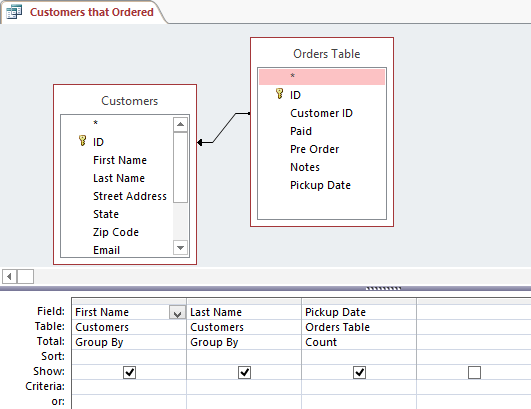 Designing a query
Designing a query
Reports
Reports offer you the power to present your information in print. If you've ever received a estimator printout of a class schedule or a printed bill of a buy up, you've seen a database report. Reports are usable because they appropriate you to face components of your database in an easy-to-read formatting. You can even customize a news report's appearance to make it visually appealing. Access offers you the power to create a report from any table Oregon interrogation.
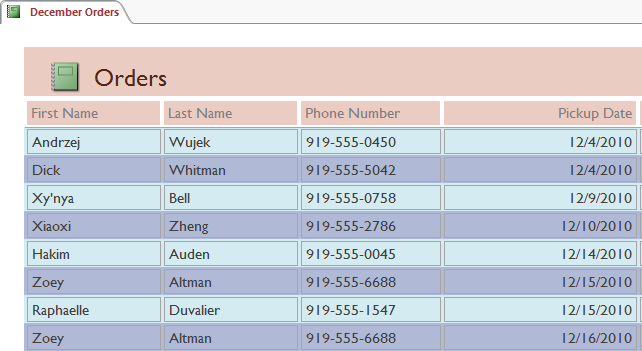 A report
A report
Putting information technology all conjointly
Even if you own a best idea of how each object can cost used, information technology can at the start be difficult to understand how they all bring together. IT helps to remember that they all process with the same information. Every piece of data a query, form, or report uses is stored in one of your database tables.
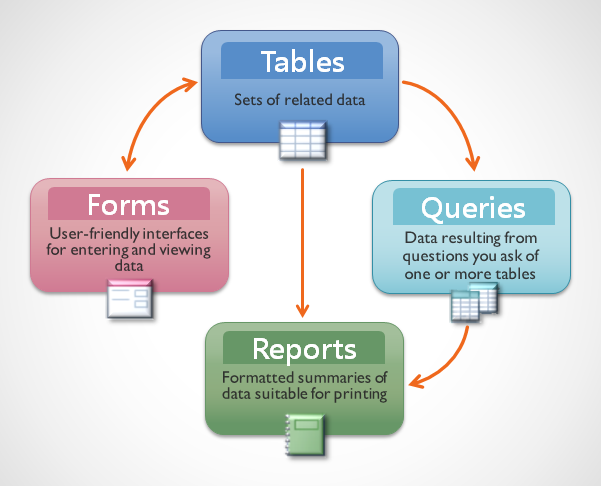 The quaternion Access objects
The quaternion Access objects
Forms allow you to both add data to tables and eyeshot data that already exists. Reports naturally occurring information from tables and also from queries, which then search for and analyse data within these synoptical tables.
These relationships sound complex, but in point of fact they wreak unneurotic indeed well and naturally that we often don't even notice when we're using connected database objects. Have you ever used an electronic card catalog to explore for a book at the library? Chances are, you entered your search in something that looks like this:
 An lepton card catalog
An lepton card catalog
When you performed your search, you were entering your search damage into a form that then created and ran a query founded on your request. When the query finished intelligent the database's tables for records that mated your search, you were shown a study that drew info from the query and the related tables—therein case, a list of books matching your search terms. You could represent the connections between the objects like this:
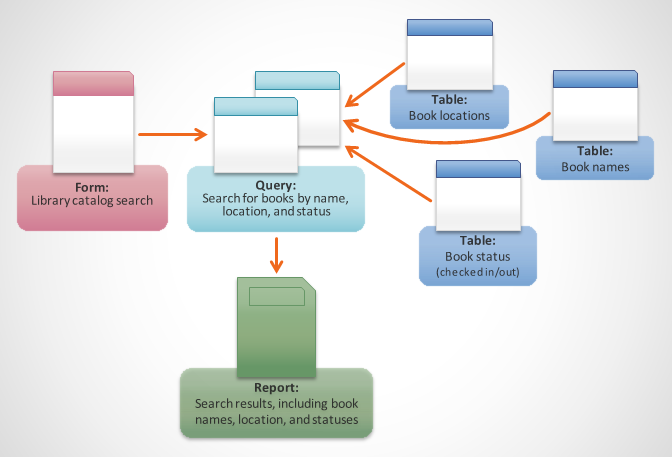 A hunting for a reserve. The data submitted in the form is used in a database query, which draws its information from relevant tables. The results of the query are bestowed in a report card.
A hunting for a reserve. The data submitted in the form is used in a database query, which draws its information from relevant tables. The results of the query are bestowed in a report card.
Let's say instead of victimization these tools you had to search within a giant table containing every book in the library system. The relevant records would likely be spread out across many a tables: a table for Book titles and descriptions, a table containing selective information along which books are curbed in or out, and a table with each branch of the depository library, just to key a few.
You'd receive to search at to the lowest degree three tables just to find a book, learn its location, and see whether it's checked in! It's uncomplicated to imagine how difficult it could go to find the right book. If you weren't careful, you mightiness even mess something up by circumstantially deleting surgery editing a record. IT's unhurried to see how the database objects make this seek a great deal more manageable.
In our Introduction to Databases lesson, we discussed the concept of a relational database, which is a database that is able-bodied to sympathize how opposite sets of information come to to single another. Situations look-alike the lesson above are exactly wherefore people feel relational databases so useful. Without a relative database, what should be a simple task—searching for a book and beholding if it's curbed in and where—becomes incredibly complex and time consuming. Knowing how to use the four Access objects can make even complicated tasks fairly user friendly.
/en/access2013/getting-started-with-access/content/
The Point Where a Row and Column Intersect Is Called a/an
Source: https://edu.gcfglobal.org/en/access2013/introduction-to-objects/1/
Post a Comment for "The Point Where a Row and Column Intersect Is Called a/an"